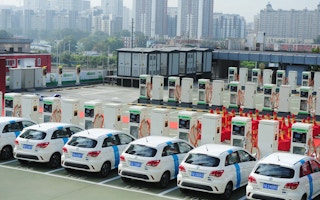Implementing three climate actions could trigger a cascade of decarbonisation in high-emitting sectors like power, transport, food and agriculture, according to a report by a United Kingdom-based advisory firm and a public research university.
To continue reading, subscribe to Eco‑Business.
There's something for everyone. We offer a range of subscription plans.
- Access our stories and receive our Insights Weekly newsletter with the free EB Member plan.
- Unlock unlimited access to our content and archive with EB Circle.
- Publish your content with EB Premium.
These actions include mandating for the sale of electric vehicles (EVs), public procuring of plant-based proteins, and requiring green ammonia to replace emissions-intensive components of agricultural fertilisers, found the research led by Systemiq and the University of Exeter.
These changes could set off a wave of “tipping points”, where consumers, producers, and investors shift decisively towards the new technology, and not look back, said the study released on Friday on the sidelines of the World Economic Forum in Davos, Switzerland.
Historically, tipping points included that when the steam engine was invented, which prompted a massive expansion of coal mining, as well as when the rail transport network in England propelled the industrial revolution, said the study.
“Tipping points happen when new technologies start to outcompete existing ones. Once you cross them, the new technology grows exponentially and forces the old one out of the market quicker than anyone could have predicted,” said Lloyd Pinnell, associate at Systemiq.
The three actions were assesed according to how the solutions were able to cross the threshold in affordability, attractiveness or accessibility in reaching the mass market, compared to incumbent fixes.
“High-emitting sectors of the economy do not exist in isolation from each other. They are highly inter-connected, and zero-emission solutions can influence transitions in multiple sectors simultaneously,” added Pinnell.
The report is financed by the Bezos Earth Fund, whose founder Jeff Bezos has his own investments in zero-emissions vehicles, green ammonia and sustainable farming through online shopping giant Amazon. When queried by Eco-Business, the study’s authors clarified, however, that neither Bezos nor Amazon were directly involved in the report.
Here are the reasons why these three policy levers could be game-changers for decarbonisation efforts:
1. Cheaper EVs could cut costs for solar and wind storage
As sales soar, the growth of EVs is nearing its tipping point, according to the study.
China, the largest car maker in the world, set a goal two years ago of having 40 per cent of the vehicles sold in the country to be EVs by 2030.
When manufacturers are required to make sure that EVs account for a bigger proportion of their car sales, they are able to overcome supply constraints and ensure bigger volumes of production, authors of the report wrote.
Passenger EVs represent the majority of the demand for batteries, estimated to account for 70 per cent of total installed battery capacity by 2030.
Batteries serve as the technology in both the power sector for solar and wind storage, and in road transport for electric cars and trucks. Increasing deployment in one sector will drive down battery costs for both industries, which are responsible for 26 per cent (power sector) and 11 per cent (road transport) of global greenhouse gas emissions.
The study estimates that if EV adoption can be boosted to 60 per cent of total global passenger vehicle sales by 2030, it will increase the total volume of battery production by 10 times from current levels.
This will reduce the cost of solar and wind storage solutions in the power sector as battery prices account for 30 per cent of the total cost of power for these solutions. The faster battery cost decline could bring forward the growth of renewables. More green energy means lower electricity bills, in turn making heat pumps even more affordable.
2. Green ammonia to narrow down price of green hydrogen for steel-making and shipping
The second tipping point is mandating green ammonia use in fertiliser production to replace those produced from fossil gas.
Green ammonia use in fertiliser production may be tapped to scale up the supply chains of green hydrogen and bring down the cost of the clean energy resource in highly-pollutive sectors, noted the study which was also supported by the World Resources Institute.
Green hydrogen may be used to curb toxic residues from steel production, which causes 7 per cent of global greenhouse emissions, while green ammonia is a carbon-free asset that may fuel the shipping industry which emits 3 per cent of the world’s pollution.
Since green ammonia can be shipped at relatively low price, only adding less than 10 per cent to the delivered cost, it can be produced in regions with the lowest hydrogen production prices, and then transported to fertiliser production sites.
Government mandates that require an increasing proportion of green ammonia in fertiliser production could be effective in establishing this as a first large-scale market.
India, one of the world’s biggest greenhouse gas emitters, has a draft hydrogen strategy that requires 5 per cent minimum green ammonia production for the domestic fertiliser sector by 2024 and 20 per cent by 2028?, in a bid to achieve net-zero carbon emissions by 2070.
3. Plant-based protein could beat cost of meat and free up 15 per cent of world’s farmland
The third tipping point identified by the study is how public procurement and investment in research and development of plant-based proteins can become cheaper than animals-based protein, without sacrificing the texture and taste. Eating meat and dairy are responsible for 15 per cent of global emissions.
A shift to alternative protein comsumption could also reduce livestock farming as a practice and free up to 15 per cent of the world’s farm land or 800 million hectares, equivalent to twice the arable land of the United States.
It is seen to ease the pressure for land conversion, which causes 11 per cent of global emissions and in turn, curb deforestation.










